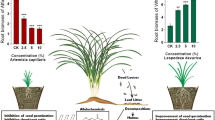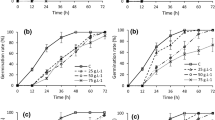Abstract
Acacia confusa (an endemic species) and other introduced species, namely A. aulacocarpa, A. auricumiformis, A. cincinnata, A. crassicarpa, A. leptocarpa, A. margium, A. polystachya, and A. torfilis were evaluated for allelopathic potential. Among these, A. confusa is widely distributed on the hills and lowlands of Taiwn and often exhibits a unique pattern of weed exclusion under stands. Four study sites were selected. Field observations and measurements were carried out at sites that exhibited relatively pure stands of A. confusa. Although the diversity of understory species was comparatively higher in Acacia stands than in adjacent weedy sites, the total coverage and biomass of understory plants was significantly lower than in control sites. Aqueous extracts (0.5%, 1%, 2%, 3%, 4%, and 5%) of dry leaves and litter of Acacia confusa and other species collected from various sites and dates were bioassayed using lettuce, alfalfa, and Chinese cabbage to examine their phytotoxicity. Most extracts exhibited phytotoxicity even at a concentration as low as 0.5%. Inhibition of radicle growth of test plants varied with sampling sites and dates. Bioassay with 5% extracts or above produced more than 85% inhibition of test plants regardless of habitat. In addition, surface soils collected from the upper 20 cm layer of Acacia stands revealed significant inhibition as compared with adjacent grassland control soils. The most inhibitory compounds isolated from the ether fraction of aqueous extracts were identified as: ferulic, vanillic, caffeic, gallic, m-hydroxybenzoic, and m-hydroxyphenylacetic acids. Unidentified flavonoids were also found. Chromatographic bioassays of compounds isolated from both ethyl acetate and water fractions of methanolic extracts of Acacia leaves also showed significant phytotoxicity but none was found in the fractions of chloroform and hexane, suggesting the phytotoxic compounds present in Acacia plants are water soluble.
Similar content being viewed by others
REFERENCES
Chou, C. H. 1995. Allelopathy and sustainable agriculture, pp. 211–223, in Inderji, K. M. M. Dakshini, and F. A. Einhellig (eds.). Allelopathy: Organisms, Processes and Applications. ACS Series No. 582. American Chemical Society, Washington, DC.
Chou, C. H. 1997. Methodology for allelopathic research. Proceedings of the 1st International Congress of Allelopathy. September 17–23, 1996. Cadiz, Spain.
Chou, C. H., and Kuo, Y. L. 1986. Allelopathic research in subtropical vegetation in Taiwan III. Allelopathic exclusion of understory species by Leucaena lencocephala. J. Chem. Ecol. 12:1431–1448.
Chou, C. H., and Leu, L. L. 1992. Allelopathic substances and interactions of Delonix regix (Boj. Raf.). J. Chem. Ecol. 18:2285–2303.
Chou, C. H., and Muller, C. H. 1972. Allelopathic mechanism of Arctostaphylos glandulosa var. zacaensis. Am. Midl. Nat. 88:324–347.
Chou, C. H., and Yang, C. M. 1982. Allelopathic research of subtropical vegetation in Taiwan II. Comparative exclusion of understory by Phyllostachys edulis and Cryptomeria japonica. J. Chem. Ecol. 8:1489–1507.
Chou, C. H., and Young, C. C. 1974. Effects of osmotic concentration and pH on plant growth. Taiwania 19:157–193.
Chou, C. H., Chang, C. M., Wang, Y. C., Hsu, F. H., and Den, W. H. 1989. The selective allelopathic interaction of a pasture–forest inter–cropping in Taiwan II. Interaction between kikuyu grass and three hardwood plants. Plant Soil. 101:207–215.
Fu, C. Y. 1995. The allelopathic potential of Acacia confusa Merr. in Taiwan. MS thesis. National Taiwan University, Taipei, Taiwan, 79 pp.
Gomez, K. A., and Gomez, A. A. 1976. Statistical Procedures for Agricultural Research with Emphasis on Rice. The International Rice Research Institute, Los Banos, Philippines.
Kuo, Y. L., Chiu, C. Y., and Chou, C. H. 1989. Comparative allelopathic dominance of tropical vegetation in Hengchun penisula of southern Taiwan, in H. C. Chou and G. R. Waller (eds.). Phytochemical Ecology. Institute of Botany, Academia Sinica Monograph Series No. 9, Taipei.
Mabry, T. J., Markam, K. R., and Thomas, M. B. 1970. The Systematic Identification of Flavonoids. Springer–Verlag, New York.
McPherson, J. K., Chou, C. H., and Muller, C. H. 1971. Allelopathic constituents of chaparral shrub Adenostome fasciculatum. Phytochemistry 10:2925–2933.
Miles, J. 1979. Vegetation Dynamics. Cambridge University Press, Cambridge, UK, 80 p.
Muller, C. H. 1966. The role of chemical inhibition (allelopathy) in vegetation composition. Bull. Torrey Bot. Club 93:332–356.
Parmar, B. S., and Singh, R. P. 1993. Neem in Agriculture. Indian Agricultural Research Institute, New Delhi, 85 pp.
Rice, E. L. 1995. Biological Control of Weeds and Plant Diseases: Advances in Applied Allelopathy. University of Oklahoma Press, Norman.
Rizvi, S. J. H., and Rizvi, V. (eds.). 1992. Allelopathy: Basic and Applied Aspects. Chapman & Hall, London.
Waller, G. R. (ed.). 1987. Allelochemical: Role in Agriculture and Forestry. ACS Symposium Series 330. American Chemical Society, Washington, DC.
Wang, T. S. C., Yang, T. K., and Chuang, T. T. 1967. Soil phenolic acids as plant growth inhibitors. Soil Sci. 103:239–246.
Wang, T. S. C., Li., S. W., and Ferng, Y. L. 1978. Catalytic polymerization of phenolic compounds by clay mineral. Soil Sci. 126:16–21.
Welte, E., and Szabolcs, I. (eds.). 1997. Agrostemin. International Science Center of Fertilizers, Belgrade. 120 pp.
Author information
Authors and Affiliations
Rights and permissions
About this article
Cite this article
Chou, CH., Fu, CY., Li, SY. et al. Allelopathic Potential of Acacia confusa and Related Species in Taiwan. J Chem Ecol 24, 2131–2150 (1998). https://doi.org/10.1023/A:1020745928453
Issue Date:
DOI: https://doi.org/10.1023/A:1020745928453




